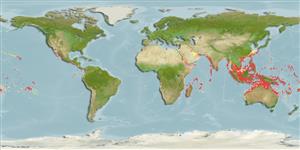Environment: milieu / climate zone / depth range / distribution range
Ökologie
seewasser riff-verbunden; tiefenbereich 1 - 90 m (Ref. 37816), usually 15 - 30 m (Ref. 9680). Tropical; 30°N - 30°S
Indo-Pacific: East Africa to the Society Islands, north to southern Japan, south to New South Wales. Not present in Hawaii (Ref. 9680). Southeast Atlantic: southeast coast of South Africa (Ref. 4423).
Size / Gewicht / Alter
Maturity: Lm ? range ? - ? cm
Max length : 65.0 cm TL Männchen/unbestimmt; (Ref. 9710)
Rückenflossenstacheln (insgesamt) : 0; Rückenflossenweichstrahlen (insgesamt) : 14 - 16; Afterflossenstacheln: 0; Afterflossenweichstrahlen: 14 - 16. Spines short (Ref. 1602). Several yellow-edged dark blotches on body (Ref. 559). D. liturosus differs from D. hystrix by its shorter spines and color (Ref. 37816).
Inhabits reef edges and slopes (Ref. 6113, 48637). Hides in caves and ledges during the day and forages at night (Ref. 9680). Also found below plate-corals during the day and often deep, ranging to at least 40 meters depth. Juveniles occur in lagoons and estuaries (Ref. 48637). Solitary. Feeds on crustaceans and mollusks. Not usually marketed (Ref. 9680).
Life cycle and mating behavior
Maturities | Fortpflanzung | Spawnings | Egg(s) | Fecundities | Larven
Myers, R.F., 1991. Micronesian reef fishes. Second Ed. Coral Graphics, Barrigada, Guam. 298 p. (Ref. 1602)
IUCN Rote Liste Status (Ref. 130435)
Bedrohung für Menschen
Reports of ciguatera poisoning (Ref. 30303)
Nutzung durch Menschen
Fischereien: weniger kommerziell; Aquarium: Kommerziell
Tools
Zusatzinformationen
Download XML
Internet Quellen
Estimates based on models
Preferred temperature (Ref.
123201): 24.7 - 29.1, mean 28.1 °C (based on 798 cells).
Phylogenetic diversity index (Ref.
82804): PD
50 = 0.5313 [Uniqueness, from 0.5 = low to 2.0 = high].
Bayesian length-weight: a=0.04786 (0.01967 - 0.11644), b=2.82 (2.61 - 3.03), in cm total length, based on LWR estimates for this (Sub)family-body shape (Ref.
93245).
Trophic level (Ref.
69278): 3.5 ±0.37 se; based on food items.
Widerstandsfähigkeit (Ref.
120179): mittel, Verdopplung der Population dauert 1,4 - 4,4 Jahre. (Preliminary K or Fecundity.).
Fishing Vulnerability (Ref.
59153): Moderate to high vulnerability (46 of 100).
Nutrients (Ref.
124155): Calcium = 30.1 [13.0, 71.5] mg/100g; Iron = 0.568 [0.289, 1.262] mg/100g; Protein = 18.5 [16.3, 20.6] %; Omega3 = 0.109 [0.055, 0.204] g/100g; Selenium = 52.1 [26.5, 109.5] μg/100g; VitaminA = 30.1 [8.7, 111.5] μg/100g; Zinc = 0.869 [0.589, 1.298] mg/100g (wet weight);
